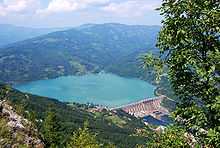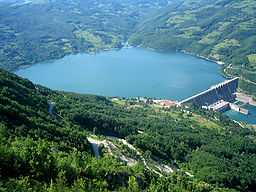Perućac lake
| Perućac Lake | |
|---|---|
|
Dam | |
| Location | Perućac |
| Coordinates | 43°58′02″N 19°24′11″E / 43.967125°N 19.403006°ECoordinates: 43°58′02″N 19°24′11″E / 43.967125°N 19.403006°E |
| Type | reservoir |
| Basin countries |
Bosnia and Herzegovina Serbia |
| Settlements | Bajina Bašta |


Perućac Lake (Bosnian/Serbian Latin Perućačko jezero; Serbian Cyrillic Перућачко језеро, pronounced [pɛrǔt͡ɕat͡ʃkɔː jɛ̂zɛrɔ]), also known as Lake Perućac, pronounced [pɛrǔt͡ɕat͡s] is an artificial lake partly in the municipalities of Srebrenica and Višegrad in Bosnia and Herzegovina and partly in the municipality of Bajina Bašta, Serbia. The lake was created by damming the Drina River and harnessing its flow to power the Bajina Bašta hydroelectric power station.[1]
The lake is notorious as one of the locations in Serbia where the transported remains of Kosovo Albanians killed during the 1999 conflict were concealed.[2] In August 2010, it became the site of a forensic operation to retrieve the bodies of Bosniak victims of the 1992 Višegrad massacres.[3]
Mass grave investigations 2001
A mass grave containing upwards of 48 bodies and possibly more than 60 was discovered near the lake in 2001. The bodies were believed to be those of Kosovo Albanians killed by Serbian forces during the 1999 conflict, brought to the lake in a refrigerated lorry dumped there during NATO air raids.[4][5][6] The burial site was a gravel spit on the north bank of Derventa River, close to its junction with Lake Perucac, 13 km from Bajina Basta and 2 km from the village of Rastiste. It contained parts of a truck refrigerator container that had formerly held the bodies. The bones and clothing retrieved showed isolated evidence of burning; there was no evidence that this had occurred at the burial site.[7]
Of 48 bodies examined by the Institute of Pathology and Forensic Medicine of Belgrade Military Hospital, 38 were male, one was female, and the sex of nine could not be established. Ages ranged from mid-adolescence to elderly. There was considerable ballistic evidence including classic gunshot wounds to the head in many cases. They had been buried for about two years and the condition of the remains indicated that they had spent some time in the water. Most were dressed in civilian clothing.[7][8] Identity documents belonging to two persons from Djakovica were found with the exhumed bodies.[9]
Dragan Karleusa, head of the Serbian police organised crime unit responsible for investigating the grave, said that in April 1999 a freezer truck containing between 50 and 60 corpses was pushed into the lake. Seven corpses immediately floated back to the surface and were removed. Two days later a container holding between 50 and 60 bodies also came to the surface. The bodies were placed in a mass grave. The head of the Serbian organised crime unit responsible for investigating the grave, Dragan Karleusa, said that the event was covered up despite the fact that numerous residents had witnessed the removal of the bodies from the reservoir.[10][11]
An anonymous reservist told the Belgrade daily newspaper Danas that he saw a freezer truck being pushed into the lake, after the water level had been lowered. A rocket had been fired into the truck to sink it but corpses started to emerge from the hole made by explosion. The bodies were buried near the village of Rastiste. The bodies that emerged two days later were buried in a separate grave, next to the first. The reservist said that the operation was characterized as a "state secret".[11] The reservist was upset that local people were supposed to allow their children to swim in the lake while officials remained silent about the bodies concealed there.[12]
A senior police officer reported that witnesses to the incident had first been threatened and were then paid 20 German marks to remain silent.[11]
The disposal of the bodies at Lake Perućac has been linked to the finding of two other submerged refrigerator trucks containing the bodies of Kosovo Albanians at Kladovo and Djerdap. It was alleged that Yugoslav Army soldiers were responsible for disposing of the bodies under orders from their superiors.[11] It is thought that at least ten and possibly dozens of truckloads of bodies were taken from Kosovo to Serbia to be dumped underwater or buried in mass graves.[12]
The investigation was set up under the authority of Sreten Lukić, the Serbian police director of public security, who served as the commander of police forces in Kosovo during the war.[12]
During the trial of police general Vlastimir Djordjevic, chief of the Public Security Department in the Serbian MUP, before the International Criminal Tribunal for the former Yugoslavia in The Hague, Djordje Keric, former chief of the Uzice SUP, gave evidence that in April 1999 he had informed Djordjevic that a refrigerator truck containing dozens of bodies of Kosovo Albanians had been found in Lake Perucac after some of the bodies surfaced. Keric had been told by the chief of the SUP Criminal Investigations Division that the bodies were those of civilians, men and women, from a sunken truck with no license plates. They were all highly decomposed and Keric was told they could not be identified. He claimed that Djordjevic ordered him to bury the bodies near the lake without notifying local legal officials or carrying out the standard scene of crime investigation procedure. Djordjevic's defence maintained that Keric decided to carry out the burials himself, not on Djordjevic's orders.[13]
Police sources alleged that Vlastimir Djordjevic had been in charge of removing the bodies from Kosovo and burying them at secret locations in Serbia as part of a "cleaning-up operation" in Kosovo ordered by Slobodan Milosevic in March 1999 at a meeting with Interior Minister, Vlajko Stojiljkovic, secret police chief Radomir Markovic and Djordjevic.[11]
During the 2010 investigation of the Visegrad massacres remains the engine and chassis of the truck were found. The Serbian War Crimes Prosecutor Vladimir Vukcevic said that the investigation was ongoing.[14]
Mass grave investigations 2010

In July and August 2010, when the level of the reservoir waters behind the Bajna Basta hydroelectric dam was lowered while maintenance and repair work was being done on the dame, the remains of many civilians who perished in the Višegrad massacres in 1992, in the early days of the Bosnian war, were discovered. The bodies of victims from the 1999 Kosovo conflict are also thought to be in the lake.[3]
Between 19 July and 9 August 2010 the remains of 60 individuals people had been found in Lake Perućac. Amor Mašović, Chairman of the Bosnian Institute for Missing Persons, who was in charge of forensic investigations at the lake, believed that they had all been killed in Višegrad or a few kilometres further upstream in Muhici and Kurtalici and their bodies thrown into the Drina River. When the bodies reached the lake they were snagged by branches or became stuck in the shallow mud and sand.[3]
Divers are also searching for bodies of Kosovar Albanians from the refrigerator truck dumped in the lake in 1999. Although dozens of bodies were recovered from the truck when it was discovered in 2003 more are thought to be in the lake, as the vehicle's doors were open when it was found.[3]
Representatives of missing persons commissions from Serbia and Kosovo joined the Institute team in carrying out a joint examination of an eight-kilometre stretch of the lake. Members of the Institute’s team were shot at from Blace village, near Višegrad, about 10 days after they began the search.[3]
The remains of at least three German Wehrmacht soldiers from World War Two have also been found during the 2010 investigations.[15]
Amor Mašović believed that there were over 2,000 bodies in the lake, making it "the largest mass grave in Europe".[16] As of 23 September 2010 remains of 373 bodies, believed to be mostly those of victims of the Višegrad massacres, had been retrieved from the reservoir, which was due to commence refilling on 26 September.[17][18] Many volunteers joined the official teams searching for the bodies but the Serbian authorities, criticised by Mašović for hampering the work, were insistent that the dam was brought back into service and refilled before the recovery work was complete.[16]
On 26 October 2010 Amor Mašović told a press conference in Sarajevo that 396 "cases" had been discovered during the two and a half month investigation. He used the term "cases", rather than "victims", because in some instances only a bone, leg, arm or rib had been found, not a complete skeleton. However he believed that between 97 and 120 victims might be identified after forensic analysis of the remains. These included six Austro-Hungarian soldiers from World War I but most were Bosniaks from Višegrad. Mašović noted that at least 800 people were still missing from Višegrad since the 1992-95 war. Veljko Odalović, head of the Serbian Commission for Missing Persons, told the press conference that discovering the fate of 14,500 victims war listed as missing in the former Yugoslavia was a "civilisation and humanitarian" issue and a precondition for reconciliation and the stabilisation of relations.[19]
See also
- Lakes of Bosnia and Herzegovina
| Wikimedia Commons has media related to Perućac Lake. |
References
- ↑ Hydro-meteorology institute (Serbian)
- ↑ "ORDER: ‘BURY THE BODIES AND KEEP QUIET’". SENSE Tribunal. 21 July 2009.
- ↑ 3.0 3.1 3.2 3.3 3.4 "Scores of Visegrad Victims Found in Lake". Balkan Investigative Reporting Network. 10 August 2010.
- ↑ "26 bodies found in Serbian grave". The Guardian. 10 September 2001.
- ↑ Zimonjic, Vesna Peric (18 July 2001). "Serb mass grave reveals secret of executed Americans". The Independent.
- ↑ "Serbs say new mass grave found". BBC. 15 July 2001.
- ↑ 7.0 7.1 "EXHUMATIONS IN SERBIA, 2001". International Commission on Missing Persons. June 2002. pp. 7–10.
- ↑ Ciric, Aleksandar (11 January 2002). "Exhumation of Mass Graves Ends". AIM.
- ↑ "A PILE OF BODIES, BONES AND FLESH". SENSE Tribunal. 17 October 2006.
- ↑ "Serbian police confirm finding mass grave". AFP. 15 July 2001.
- ↑ 11.0 11.1 11.2 11.3 11.4 Nikolic, Ivan (19 July 2001). "Serbia Exhumes Mass Graves". Institute for War & Peace Reporting.
- ↑ 12.0 12.1 12.2 Gall, Calotta (31 July 2001). "Serbia Finds Where Bodies Are Buried, and Investigates". The New York Times.
- ↑ "DEFENSE: DJORDJEVIC HAS NOTHING TO DO WITH COVER-UP". SENSE Tribunal. 22 July 2009.
- ↑ "Search for murdered Albanians at lake Perucac under way". Tanjug. 10 August 2010.
- ↑ Jelenek, Miran (9 August 2010). "Balkan river still bleeds the dead of wars past". Reuters.
- ↑ 16.0 16.1 "Bosnians Find Mass Grave In Lake". Eurasia Review. 18 September 2010.
- ↑ "Insititut za nestale BIH: ekshumirana 373 ostatka". Radio Free Europe/Radio Liberty. 23 September 2010.
- ↑ "INOBiH: Ekshumacije na jezeru Perućac do 26. septembra". Vijesti.ba/Fena. 23 September 2010.
- ↑ NDTV Indo-Asian News Service, 27 October 2010, accessed 24 January 2011
External links
- Agency of the Republic of Srpska Water river basin district: Lakes in the Republic of Srpska (Serbian)
- Hydrometeorological Institute of Srpska: Lakes in the Republic of Srpska (Serbian)
- Drina river: Perućac (Serbian)
- Perućac lake (Serbian)
- "Searching for Closure" - Dijana Muminović's photographs documenting the 2010 investigations at Lake Perućac, accessed 24 January 2011
- "Waters of the Drina, guard their graves", by Hikmet Karcić, The Comment Factory, 21 October 2010 (a volunteer's account of the 2010 investigations), accessed 24 January 2011
- Accommodation near Perucac lake and beautiful photos - Map